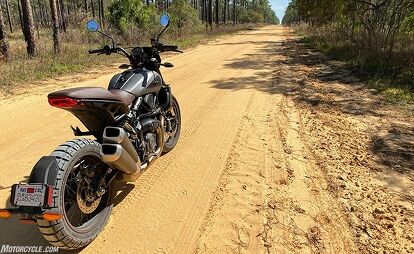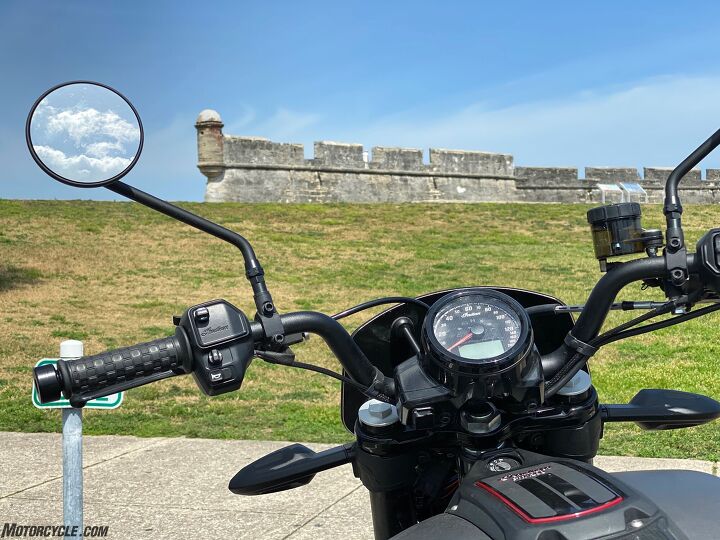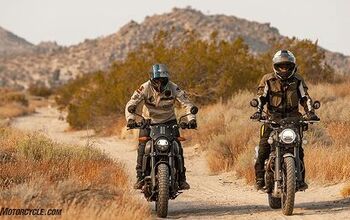Social Distancing With Indian's New FTR1200 Rally
Singing in the Key of C-19 at Daytona Bike Week
Way back in the old days of early March 2020, a huge crowd assembled among gathering clouds. The Supercross at Daytona ran on schedule to packed stands. It would be the last major motorcycle race for the foreseeable future, but we didn’t know that. The witnesses were mostly young and beautiful: These are the people who will carry the world forward when our boomer lungs fill with pus, and we utter our final, intubated gurgle. We saw the crazy reports of toilet paper hoarding circulated on social media. We weren’t blind. We knew something was coming. On this, our last night of innocence, we sat shoulder to shoulder blasting out throaty cheers to over-modulated rock music and watched Eli Tomac slowly reel in and then pass Ken Roczen to take the win. Then the shit hit the fan.
Daytona’s remaining races were first declared off limits to spectators. I checked in with Speedway officials and found my Motorcycle.com media passes would allow me access. Then a day later Speedway officials declared the races off limits to everyone. The show was canceled. The huge, motorcycle-product tent city erected in Daytona’s parking lots began to thin as vendors packed up their wares. The whole town seemed to lose its will to go on – except for the Harley riders whose exhausts raged on, impervious to fear. I still had a loaner Indian FTR1200 Rally for a few days. Shelter in place was the directive. So, I decided to clear out with everyone else and explore the lonely tracts of the Ocala National Forest.
The Cross Florida Barge Canal is a centuries old idea. The on-again, off-again attempt to create a water route from the Atlantic Ocean to the Gulf of Mexico via Central Florida is off at the moment. I’m not fully convinced the game is over, as the partially completed canal seems a hard thing to resist for politicians seeking boondoggle money. Slicing through Florida’s shallow aquifers, mixing sea water with fresh, the canal project had environmental issues from the very beginning and has been repurposed into a natural path called the Cross Florida Greenway. That’s where I took Indian’s new FTR1200 for a little sand-to-sand combat.
Eastward from Highway 19, the Greenway gets dirty. The COVID-19 virus will have a hard time finding me on this road of compacted sand. It’s a smooth-ish high-speed dirt road mixed with loose sugar sand. The FTR has such a luxurious amount of power 6th gear roll-ons send long roostertails of sand slashing through the pine scrub. It’s a wonderful feeling to never want more, and in the dirt, the FTR gave me all the power I could possibly want.
Let me clear this up right now: the FTR1200 Rally is not a dirt bike. It has knobby tires, but one look will tell you it’s a streetbike. The thing is, the definition and dimensions of an off-road bike have changed greatly since the advent of large, heavy ADV motorcycles. Going by the new, 600-pound-ADV standard, the FTR is a relative lightweight at 500 pounds and a nimble machine to boot. Deep sand, the kind of sand you get on the tight corners of The Greenway, were best taken at a walking pace. Other than that, I had no problem hustling the sturdy little 1200cc bike down graded dirt roads at 50 to 80 miles per hour. The Rally could go faster in the dirt but not with me at the controls.
After 20 miles the Greenway intersected pavement, and I turned the FTR north towards another tenuous canal tie-in. Only a century after Philip II, the King of Spain, Portugal, Naples, and Sicily first proposed the Cross Florida Canal, work began in 1672 on the Castillo De San Marcos fort in Saint Augustine, Florida.
The fort is a huge tourist attraction, and as this was still in the early days of virus alerts, the place was crowded with sweaty, sunburnt, disease vectors. I thought with the government order to close everything I could sneak in to see the fort, but the lines were long, people were close-coupled. I didn’t want any part of that scene.
The FTR pulls hard up to an indicated 130 miles per hour before the electronic speed limiter kicks in; 130 in 6th gear is only 7200 RPM. The speedometer number spacing tightens up over 120 mph, making it hard to tell exactly what speed you are traveling, but really, at that pace, your eyes should be on the road. The FTR will do 130 in 5th gear, also electronically limited. The remaining gears hit the rev limiter around 9000 rpm. It’s a hard cut-off that gets annoying if you live near redline, and the Rally gets to redline quickly in whatever gear you choose.
I made it back to the safety of the Ocala Forest pretty fast, burning through gasoline at the rate of one gallon for every 40 miles traveled. The most fuel I put in the FTR’s 3.4 gallon under seat tank was 2.5 gallons, and the low fuel light never illuminated.
By the next morning, hard-core capitalists were talking about handing out free money to everybody, the stock market reached new lows, verified cases of COVID-19 doubled, schools closed, and grocery stores were stripped bare by a frightened public intent on hoarding whatever they could get their hands on. It wasn’t a good look for America. We like to think of ourselves as heroic cowboys, never ruffled, always true. We became The Good, The Bad, and The Ugly rolled into one.
Outside, it was like any other beautiful March day in Florida. The sun rose; the warmest Daytona Bike Week weather I can remember continued, hitting 90 degrees. I took advantage of the dry weather to explore Kismet Road, a route that had stopped me in the past due to deep water. The water level was down, replaced by sections of deep sugar sand. I dropped the FTR into first gear and paddled through. The FTR’s weight is low and balanced making footwork fairly easy. Kismet exits onto Highway 42, the closest thing to twisties you’ll find in Central Florida.
Hanging on the front of the FTR Rally’s engine are a few things you shouldn’t smash into rocks. There’s an oil cooler on the right, and on the left is the battery with a finned aluminum voltage regulator. The battery is inside a plastic box. So, I don’t think a stray rock kicked up by the front wheel will hurt it. Rock crawling or curb hopping could do some damage.
The FTR Rally has less electronic widgets than the full-boat FTR. The instruments are analog instead of touch screen, there are no power settings (it’s full power all the time), and the ABS system cannot be turned off like the touch screen model. All things considered, I like the simpler Rally except you really need to be able to turn the ABS off in the dirt. With ABS activated the rear brake is useless in sand or traction-compromised situations. Luckily, most ABS front brakes seem to work well in the dirt, and the Rally’s front brake was no exception.
If you’re shaped like me: short, fat, and neck-less, the FTR Rally will fit perfectly. I loved the handlebar/seat/foot peg relationship. The thing was like Posturepedic designed a motorcycle. On the Rally I was tilted slightly forward with my feet directly under my butt. The handlebars were plenty wide and right where I wanted them. The Rally has a mildly aggressive stance, but it put me in mind to try anything. I didn’t fear deep sand bogs or tight trail u-turns like I would have on a bigger motorcycle with a cruiser-ish, feet forward, spine-curving slouch. But then what are you doing out in the woods on that type of motorcycle?
The Rally’s seat is narrow at the front then grows wider a few inches back. Being chimp-of-leg, the foot peg location blocked a firm stance when stopped, but I could still reach the ground okay thanks to that narrow section. It felt like a dirt bike for sure. There is a ridge cutting across the seat that forms a bucket for the rider. It’s comfortable on the street and good during hard acceleration, but I would prefer a flatter seat which would allow me to put more weight on the back tire in off road situations. That hump hampers my movement, man.
A motorcyclist must have laid out Highway 42 because the pavement gently sways for no reason at all. Florida is amazingly flat yet some unsung hero took care of us motorcycle riders for a few miles. On the street, the FTR is supremely composed. Braking is strong. There are no wobbles, the bike is never out of sorts. The Rally feels like solid material instead of built up from individual parts. Cracking the throttle in the first two gears causes the front wheel to come off the ground. The bike hits so hard in first gear that the tire spins. It does a wheelie and then smacks into the rev limiter all at the same time and within what seems like 30 feet.
I really like this motorcycle. The Indian FTR Rally is so good it joins the thinly populated ranks of modern motorcycles I would own. Indian sells an accessory rear rack that I would buy before I left the showroom. Another thing I would do before leaving the dealership is remove that awful rear hugger/turn indicator/license plate holder thingy. It looks like something the Borg would attach to assimilate your motorcycle. Indian needs to find the designer who drew up that hugger and transfer him to the toaster division of Polaris. (Then again, there’s already an accessory in the Indian catalog to get rid of it: Item# 2884060.)
By Saturday the entire world was completely freaked out. Italy was overrun with coronavirus victims. I started to worry about getting home to New Mexico. What if the government blocked interstate travel? What if gas stations closed up? In all this confusion, could I keep the Rally without Indian noticing? Would motels take guests? Would grocery stores have food? It was that kind of crazy. I rode the FTR Rally back to Indian’s Main Street location. I was just in time because the crew had their sprawling Indian parking lot display broken down and mostly packed away. The Saturday of the 200 is normally the busiest day during Bike Week, but this Saturday was lost to the chaos engulfing America.
A tiny virus, COVID-19 has beaten Daytona this year. Hang in there MOrons, because Bike Week 2021 is already spinning our way, cutting a graceful helix through the dark infinite universe. We will arrive and one day the sound of racing motorcycles will again rip through the balmy Florida night and throaty cheers will blast from strong, beautiful fans packed shoulder to shoulder.
More by Joe Gresh



















































Comments
Join the conversation
Great story, Joe. I wish there was more of it. Maybe you'll provide a sequel?
Here’s a little more:
https://m.youtube.com/watch...